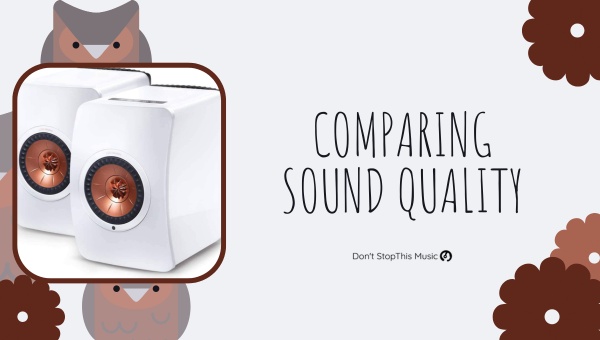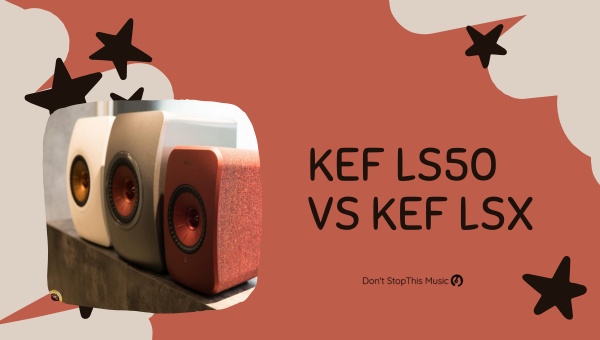When it comes to selecting speakers for your home audio system, the KEF LS50 and KEF LSX stand out as two popular choices.
Each offers its own set of advantages and it’s crucial to understand the differences between them in order to make the best decision for your individual needs. In this article, I’ll delve into the specifics of these two speaker models, comparing their features, capabilities, and value.
Identifying your priorities and preferences is essential when choosing between KEF LS50 vs KEF LSX. With this information in hand, you’ll be better equipped to decide which speaker is the perfect fit for your audio desires.
Comparing Sound Quality: KEF LS50 vs KEF LSX
During my time with the KEF LS50 and KEF LSX speakers, I couldn’t help but notice the differences in sound quality between the two models. In this section, I’ll dive deeper into what sets these two apart and highlight some of the key aspects when it comes to their audio performance.

The KEF LS50 speakers boast a Uni-Q driver that combines both the tweeter and mid/bass driver into one unit, providing an incredibly accurate and cohesive sound. This innovative design allows for better detail and imaging since the sound comes from a single-point source. Additionally, the LS50 has a frequency response of 79Hz – 28kHz which offers a decent bass extension for a speaker of its size.
On the other hand, the KEF LSX is a more compact and versatile option, featuring a 4-inch Uni-Q driver. One major advantage of the LSX is its wireless capabilities, allowing for easy connectivity and flexible placement options.
The LSX sports a frequency response of 54Hz – 28kHz, which is impressive for its size. However, it’s worth noting that the LSX may lack some of the precision and depth offered by the LS50 in certain scenarios.
To further examine the sound quality of the LS50 and LSX, I put them through various listening tests with different genres of music. Some of the key observations include:
- For bass-heavy tracks, the LS50 truly shines with its larger driver, providing greater bass extension and impact compared to the LSX.
- Vocal performance stands out on both speakers, but the LS50 offers a slightly more natural and lifelike rendition.
- In terms of soundstage, the LS50 has a clear advantage, delivering an expansive and immersive listening experience, while the LSX still performs well but is better suited for smaller spaces.
Also Read: Vandersteen 2Ci vs 2Ce: Comparing Speakers in Detail
Design and Aesthetics: KEF LS50 vs KEF LSX
Diving into the design and aesthetics of the KEF LS50 and KEF LSX models, it’s evident that the manufacturer prioritizes both form and function. I’ve been attracted to both models, captivated by their sleek, modern appearance and unique features. Allow me to break down the design elements of these two outstanding speaker series:

Firstly, let’s discuss the KEF LS50. This speaker model sports a timeless and elegant design. Known for its Uni-Q driver array technology, it enables a seamless blend of low and high-frequency sounds. That means you’ll get an exceptional listening experience.
The LS50 series is available in four different color combinations: Gloss Black, Gloss White, Titanium Grey, and Racing Red, accommodating diverse aesthetic preferences. Moreover, it features a curved front baffle providing optimal sound dispersion.
On the other hand, the KEF LSX also leaves a strong impression with its stylish forms. The LSX series showcases the signature Uni-Q driver array but in a more compact package. The LSX offers five vibrant color options: Black, White, Maroon, Olive, and Blue to match any interior decor. The speakers can either be mounted on stands or bookshelves. Compared to its sibling, the LSX is a more versatile and affordable option.
Here are some noteworthy design features of the KEF LS50 and KEF LSX:
- Both models incorporate the Uni-Q driver array technology, which ensures optimal sound dispersion.
- The LSX model is smaller and lighter, making it a more versatile option for various room sizes.
- Numerous color options are available, allowing you to choose the style that best suits your taste and space.
Setup and Connectivity: KEF LS50 vs KEF LSX
In my experience with both the KEF LS50 and KEF LSX speakers, I’ve found the setup process to be relatively simple and straightforward, but with some key differences between the two. For those who prioritize easy connectivity and setup, it’s essential to understand the distinctions between the two models.
The KEF LS50, which is the more premium option, offers a wide range of options for connectivity. Designed for a more versatile and high-end setup, it provides:
- Wired Connectivity: Traditional speaker wire inputs and binding posts for secure connections
- Digital Inputs: USB Type B, Optical TOSLINK, and RCA/Coaxial inputs for digital devices
- Analog Input: RCA phono input for turntables and other analog devices
In contrast, the KEF LSX is designed more for convenience and simplicity, making it a great choice for those who prefer a plug-and-play solution. It offers:
- Wireless Connectivity: Bluetooth 4.2 with aptX for streaming from mobile devices and computers
- Digital Input: Optical TOSLINK input for digital devices
- Analog Input: 3.5mm auxiliary input for connecting analog devices
When it comes to setup, the KEF LS50 requires a bit more attention due to its wired connections. An external amplifier or receiver is necessary to power these speakers, so you’ll want to factor that into the overall setup process. Once the speakers are connected to the amplifier or receiver, they can be configured using the provided remote control.
On the other hand, the KEF LSX was designed with ease of use in mind, focusing on simplicity and a user-friendly experience. These speakers have a built-in amplifier, so no additional equipment is needed.
They can also be controlled using the KEF Control App, making it easy to adjust settings and preferences right from your smartphone. Additionally, the LSX features a unique wireless inter-speaker connection, so there’s no need for a cable between the two speakers, freeing up space and reducing clutter.
Also Read: AKG C414 XLS vs XLII: Unveiling Key Differences
Size and Portability: KEF LS50 vs KEF LSX
When it comes to comparing the KEF LS50 and KEF LSX speakers, I’ve found that size and portability play a major role in determining which one is more suitable for a specific space or user. Let’s dive into the size differences and portability aspects of these two models.
| Model | Height | Width | Depth | Weight |
|---|---|---|---|---|
| LS50 | 11.9″ | 7.9″ | 10.9″ | 15.87lbs |
| LSX | 9.5″ | 6.1″ | 7.1″ | 7.9lbs |
The KEF LS50 speakers are larger and heavier compared to the LSX model. With dimensions of 11.9″ x 7.9″ x 10.9″ (H x W x D) and weighing 15.87 lbs, these speakers are intended for a more permanent setup. However, the greater size and heft contribute to their impressive sound performance.
On the other hand, the KEF LSX speakers are more compact and lightweight, measuring 9.5″ x 6.1″ x 7.1″ (H x W x D) and weighing around 7.9 lbs. This makes them easier to move around and set up in various locations. The smaller size might be more suitable for smaller living spaces, bedrooms, or offices.
Now, let’s discuss the portability factor:
- KEF LS50: Due to their larger size and heavier weight, these speakers are less portable and ideally suited for a dedicated listening area. However, they provide incredible audio performance and are worth the investment if you’re looking for a more static setup.
- KEF LSX: Much more portable than their bigger brothers, the LSX speakers can easily be moved around to different rooms or taken on the go when needed. Their compact design makes them perfect for users who prioritize flexibility and portability over the sheer power of bigger speakers.
Another aspect to consider in terms of portability is the ease of setup. The LSX speakers are designed with wireless connectivity and a user-friendly app, making it simple to set up and connect to various streaming services. In contrast, the LS50s require a wired connection, which may add some complexity to the setup process.
The KEF LS50 and KEF LSX each have their own strengths when it comes to size and portability. The LS50s might be more suitable for those who prioritize audio performance and a static setup, while the LSXs cater to users looking for compact, easily portable speakers with wireless connectivity for a more convenient setup experience.
Also Read: Mackie CR3-X vs CR4-X: A Detailed Comparison
Price and Value
When considering the KEF LS50 and KEF LSX, it’s essential to evaluate their respective price points and the value offered. As a speaker enthusiast and someone who’s tested both of these high-quality products, I’m here to give you an insider’s perspective on the price and value aspects of each speaker.
KEF LS50: The LS50, being the older and more prominent model, comes with a heftier price tag. They retail at around $1,299.99 per pair. Despite its cost, the LS50 undoubtedly provides a higher level of sonic performance and accuracy that audiophiles crave.
KEF LSX: On the other hand, the LSX speakers strike a balance between price and performance, making them an appealing option for those who don’t want to break the bank. Priced at approximately $1,099.99 per pair, they offer a more budget-friendly option.
Let’s examine some critical factors of each speaker to provide a better understanding of their value:
Performance
- LS50: Known for their exceptional sound quality, with a wide soundstage, and detailed highs and mids. These speakers are designed for listening to music with a focus on accuracy and transparency.
- LSX: Though not as powerful as the LS50, the LSX still delivers impressive sound quality, particularly for smaller rooms. Their compact design and built-in amplification make these speakers an attractive choice for those with limited space or seeking an all-in-one solution.
Connectivity
- LS50: The LS50 requires an external amplifier and additional cables for connectivity, which may not be an ideal choice for those looking for a more minimalist setup.
- LSX: The LSX is designed for seamless connectivity, with Bluetooth and Wi-Fi capabilities. They also offer hassle-free installation, minimizing the need for extra cables and amplifiers.
Design
- Both the LS50 and LSX boast an eye-catching design with a curved cabinet and the unique KEF Uni-Q driver.
- The LSX, however, comes in various vibrant colors, allowing for more personalization and the opportunity to match the speakers with your room décor.
Ultimately, it’s crucial to evaluate your own needs and preferences when selecting between the KEF LS50 and KEF LSX.
While the LS50 does provide a more impressive overall sonic performance, the LSX offers several features geared towards convenience, making them better suited for casual listening and smaller setups.
Final Thoughts
In conclusion, both the KEF LS50 and KEF LSX offer exceptional audio performance with unique features that cater to different preferences and priorities. If you’re an audiophile seeking top-tier sound quality, precision, and a more traditional speaker setup, the KEF LS50 is likely your best bet.
However, if convenience, wireless connectivity, and compact design are high on your list of priorities without sacrificing too much in terms of sound quality or performance, then the KEF LSX may be the better choice for you.

